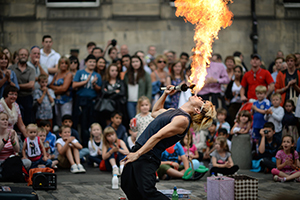EAM Co-ops on the Fringe
September 23, 2013
 Entertainment & Arts Management (EAM) Assistant Professor Dr. Xela Batchelder has managed a mid-sized venue at the Edinburgh Festival Fringe – the world’s largest fringe festival – for more than thirteen years, presenting performances, lectures and workshops as well as conducting extensive research on the structures of the Edinburgh Fringe and other fringes festivals. This past summer, she took EAM students Samantha Wend, Julie Mercik and Alison Pajonk to Scotland to participate in Edinburgh Festival Fringe’s Traverse Through Time project celebrating the fiftieth anniversary of the world-famous Traverse Theatre. Their experiences included a whirlwind tour of Scotland’s deep cultural history, an appearance on the BBC’s Culture Show, and they were there when artist and arts presenter Richard Demarco, Batchelder’s long-time collaborator, became the first Scotsman to receive the European Citizens’ Medal.
Entertainment & Arts Management (EAM) Assistant Professor Dr. Xela Batchelder has managed a mid-sized venue at the Edinburgh Festival Fringe – the world’s largest fringe festival – for more than thirteen years, presenting performances, lectures and workshops as well as conducting extensive research on the structures of the Edinburgh Fringe and other fringes festivals. This past summer, she took EAM students Samantha Wend, Julie Mercik and Alison Pajonk to Scotland to participate in Edinburgh Festival Fringe’s Traverse Through Time project celebrating the fiftieth anniversary of the world-famous Traverse Theatre. Their experiences included a whirlwind tour of Scotland’s deep cultural history, an appearance on the BBC’s Culture Show, and they were there when artist and arts presenter Richard Demarco, Batchelder’s long-time collaborator, became the first Scotsman to receive the European Citizens’ Medal.
Demarco’s Traverse Theatre was established in 1963, and has nurtured some of Britain’s greatest writing talents and provided an invaluable platform for innovative and challenging new work. Batchelder created the Traverse Through Time Project after receiving the Westphal College Creative Fund Grant, which she used to produce an exhibition of photos, posters, flyers, programs and articles from the first few years of the Traverse’s founding, with artifacts displayed and shared courtesy of the Richard Demarco archives. The line-up of event speakers included actor/writer/director Steven Berkoff, playwright Peter Arnott, artistic director Orla O’Loughlin, and former President and Chair of the Association for Scottish Literary Studies, Ian Brown.
EAM Senior Julie Mercik was especially moved by Ian Brown’s session at Traverse Through Time. “Ian surprised me by not bringing any written notes, but supplied a steady stream of history on the Traverse Theater from its creation up until the 1970s,” says Mercik. “Ian provided an objective view on the Traverse and was not afraid to point out that the work it produced wasn’t always ‘on the cutting edge,’ but rather, it was the seemingly impossible space it resided in that made it a completely unique theater … He did not shy away from offering his opinions and made it clear that there is no one definitive answer when it comes to theater.”
Batchelder says that some of her students join the EAM program specifically for the chance to work at the Edinburgh Fringe. “You never know whom you are speaking with at the Fringe. It could be an important producer or someone who could put you in touch with someone that could help your career,” says EAM student Alison Pajonk. “There are so many things to do at the Fringe, where I have heard many people state that ‘sleep is for September.’ Although Fringe University students are not putting on a show here, learning all the ins and outs of the festival will be so helpful for us in the future. Whether we are back at the Fringe one day, or managing a show touring in the United States, the information we have been given at these workshops can be applied to all aspects of the entertainment industry.”
Batchelder’s Traverse Through Time project was well received, generating positive reviews from Informed Edinburgh and Broadway Baby writer Gwen Sims-Williams, who wrote “this exhibition really does capture the spirit of the innovative edge that transformed Edinburgh into a global cultural capital from the mid-60s onwards.” Batchelder was also interviewed in Johannes Bockwoldt’s documentary, “Fringe – A Festival for the City,” which chronicled the process of producing Rochester, N.Y’s First Niagara Rochester Fringe Festival in 2012.
Click here to visit the Traverse Through Time website.